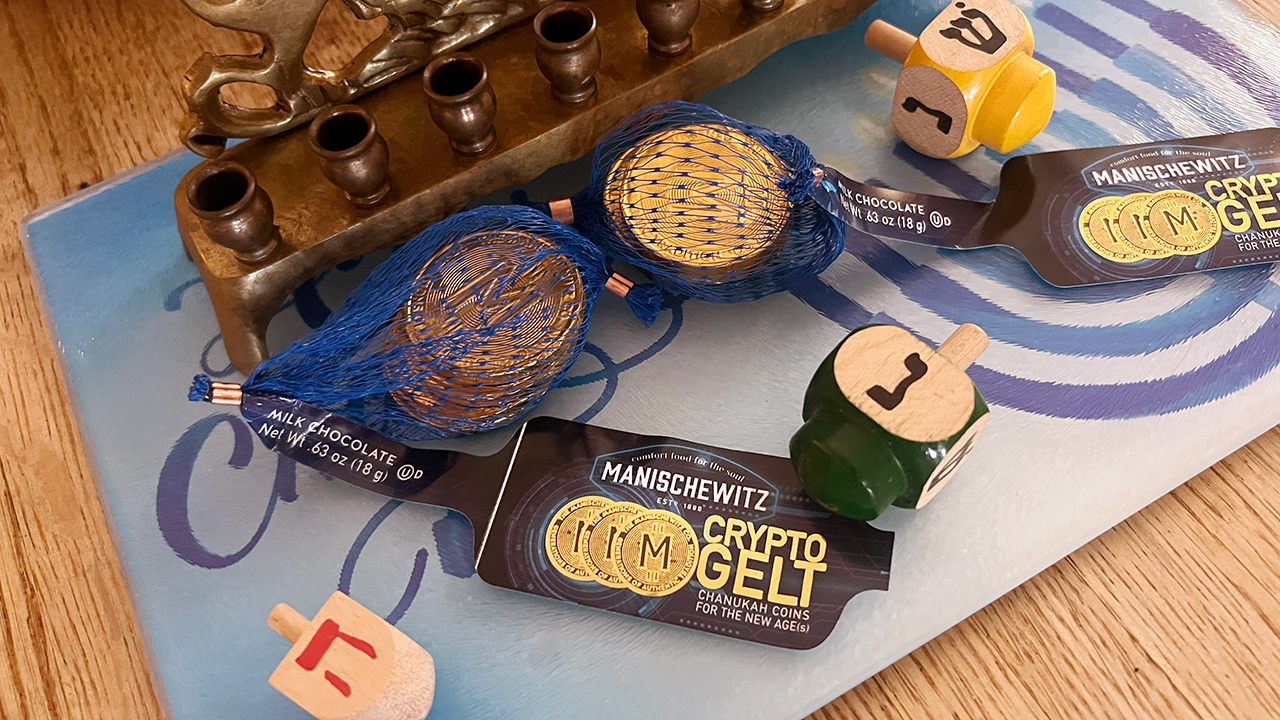My general policy on crypto is to think about it as little as possible and stay as far away from it as is practical without coming across like an asshole. Every time someone has tried explaining crypto to me, my mind has reached the same conclusion: This sounds complicated, and anything that complicated—and that unregulated—will not end well, at least for the little guys, and thus it is none of my business.
Then came the crypto gelt.
Gelt are chocolate coins traditionally eaten to help celebrate Hanukkah. (Please know that here I considered going into a lengthy explanation about why, but I ran that idea by my non-Jewish better half and he wisely advised me to keep this short and link out to an explainer instead—"my people like our holiday stuff simple," he said.) What matters more is that gelt is probably one of the more widely known Jewish traditions here in the United States because, if you live in an area with a Jewish community, you know that around December those chocolate coins start popping up in the local grocery stores. I have found through my very unscientific process of being Jewish that most people a) know about gelt and b) like it a lot. How could they not? It's freaking chocolate.
Gelt can be silly, or gelt can be serious. Gelt can be custom. Gelt can be milk chocolate or dark chocolate or vegan. Gelt can even be—gasp—made of white chocolate! You can't really screw it up—it's piles of candy you get to eat for "religious reasons." Sure, God didn't directly say, "And on this day you will eat chocolate," and technically Hanukkah is a minor holiday that got puffed up so us Jewish kids wouldn't feel bad about not having Christmas, but I'm confident that if we squint hard enough at the Talmud like one of those Magic Eye posters of yore, something about the sacredness of sweets will emerge. Until this week, I would have said that it's impossible to do gelt wrong. Like I said, it's freaking chocolate.
So you can imagine how I felt when my colleague Dan McQuade sent me photo evidence of crypto gelt being sold. What is crypto gelt, you ask? It is simply regular gelt, but with a Bitcoin-style logo on it. Who thought this is a good idea? Why must something as sweet and pure as gelt be sullied by, blech, crypto? Have any of these people read the damn news lately? Like a true investigative journalist, I did my best to confirm the existence on my own, but the local grocery store that I went to did not have crypto gelt, just traditional gelt. I considered doing an entire odyssey in search of the crypto gelt, however, a) I had to get up early and b) the company behind the crypto gelt had already officially confirmed its existence.
"Manischewitz has launched the first edible chocolate 'crypto' coin that can be collected, shared, and traded this holiday season," SnackAndBakery.com reported. "Unlike traditional cryptocurrencies, like Bitcoin and Ethereum, which are completely digital, usually without physical form, Manischewitz Crypto Gelt is made from milk chocolate, in packaging that mirrors the most well-known logos of popular cryptocurrency."
In other words, this is gelt but rebranded it to make it, ya know, hip or something, I guess. It was only a matter of time before some executive walked into a large office and said: I've got a great idea! We need to rebrand gelt! Or maybe it was: Gelt needs to get in on this cryptocurrency trend! Any doubt in my mind that this was little more than a marketing ploy dissipated upon seeing that the Manischewitz Twitter account tweeted about this to Elon Musk. (Curious how the value of crypto gelt compares to actual crypto? On the high end, a single Bitcoin goes for more than $16,000 and Ethereum goes for more than $1,200. But then things drop off for crypto. XRP is worth 35 cents, and Dogecoin is worth seven cents. Meanwhile, 144 coins of crypto gelt will set you back $21.99, before taxes, which is about 15 cents per coin.)
Since I have yet to experience crypto gelt in person, I asked McQuade to weigh in on it. He did so, in true McQuade fashion:
"As you might be able to tell by my last name, my wife is the Jewish one. One of the most enjoyable parts about learning more about Judaism over the years is how similar it is to my Catholic upbringing. My family has been unknowingly exchanging chocolate gelt my whole life—only the coins mimic JFK half-dollars. I have yet to eat crypto gelt, though. I figure I’ll hold onto it: Like crypto, I can only imagine it will go up in value indefinitely."
Hanukkah has always been a bit of an odd duckling in the canon of Jewish holidays. Like I said, it's a minor one. It's not from Torah. God did not tell us directly to celebrate this day. (But, as this article from Chabad.org points out: "Nevertheless, G‑d is above the limitations of time, and as such, He included in the Torah allusions to Chanukah." Obviously!) It does not carry the weight of Rosh Hashanah or the solemnity of Yom Kippur, nor does it have the explosive joy of Purim or Simchat Torah. It's a big deal because of the United States. Hanukkah gives Jewish kids something, anything, to counteract the onslaught of Christmas-Santa-Jesus-presents that starts around Thanksgiving and never lets up until Dec. 26. It's a way for Jewish people to feel like they too have been invited to the annual holiday extravaganza. It is, I suppose, perhaps not an important holiday in and of itself but, at the same time, a part of larger tapestry of customs and traditions created by the Jewish diaspora to feel a little less other in whatever place they have made their home.
But it is also not Jewish Christmas. (Please, never say that.) Like a lot of non-Christian holidays, this country's corporate culture doesn't seem to quite know what to make of Hanukkah. For example, I'm using "Hanukkah" because that's the official Associated Press style spelling but, in my heart, Chanukah gets way closer to how it actually sounds in Hebrew. As The Forward recently noted, it's a holiday all about going to war and killing lots of people—and yet the related merchandise seems to grow increasingly cheesy. There's even an entire Instagram account, Hanukkah Fails, dedicated to the many, many foibles of merchandise so ridiculously wrong that the only explanation can be some version of not only were Jews not consulted, but nobody even bothered to Google Hanukkah. There is always at least one catastrophe that goes viral, and you might have already seen the latest edition: A menorah that, when you hold it at a certain angle, sure looks like a penis. (Full disclosure: The proper term for what's used on Hanukkah is a hanukkiah, not menorah, but everyone says menorah. It's fine. I'm mostly writing this aside because I still live with a dash of fear of one of my Hebrew school teachers reading this, then sighing and going: Oh, Dvorah-leh, we thought we taught you better than that.)
So what do we do with the crypto gelt? We don't buy it, if we can help it. But if it's around, we eat it. I thought long and hard about how to end this little missive. Do I get upset about the way our consumer culture devours everything in its path? Do I lament how the Manischewitz company behind this crypto gelt at one point was sold to an arm of private-equity giant Bain Capital, before merging its food products with another kosher-food giant, Kayco, and which, by the way, is entirely separate from the wine, which has the name Manischewitz but is not made by Manischewitz? Do I scream that I hate that this is a dumb marketing ploy, and I am kinda giving credence to that marketing ploy by writing about this?! No. Sometimes, I believe it's OK to be practical. There is a time to search for meaning, a time to find the hidden significance in the text—and a time to just get through your day and then eat the damn chocolate. Sure, crypto gelt is stupid. But as any bubbe would say: It's chocolate. Don't waste it! And that is the wisdom that has kept the Jewish people alive for thousands of years.





